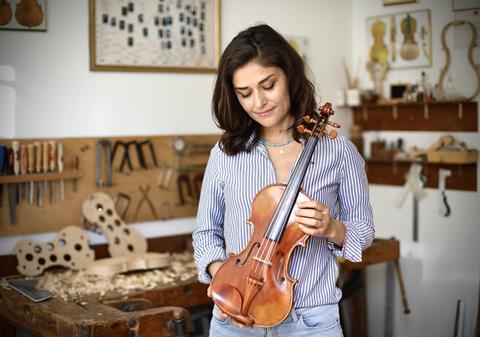Luthier Nurgul Comak offers a guide on instilling good cleaning habits and techniques to ensure the health and longevity of your stringed instrument

If trees that can live for centuries had a language, they would have thousands of stories to tell. Violins and other instruments in its family, the raw material of which are wood, are living beings. Don’t forget that! Make a point of being more compassionate towards your instrument. This will not only help you to play more pleasantly, but also ensure your instrument stays healthy for many years.
In the course of time, dust, rosin, and sweat accumulate on your instrument. Rosin is an acidic and sticky substance. When it stays on your instrument for a long time, it will cause the pores to close, affecting the instrument’s voice negatively. When you clean your instrument, you will not only make its appearance better but also protect its sound.
Cleaning the surface of your instrument:
First of all, for you and your instrument’s health, make a point of using high-quality rosin. When playing your instrument, your hands should be clean. If you get into the habit of ’daily care’ after playing your instrument, you won’t have to do a big clean.
For your instrument’s daily care, you need a soft brush (such as a make up blush brush) and two dry lint-free cloths. First, remove the dust from the strings and the instrument with a brush, and take the rest of the dust with a dry cloth. With your second cloth, wipe and clean the neck and the fingerboard under the strings to remove sweat. Wash your brush with soapy water once a month and wash your cloths with soapy water at least once every two weeks to keep them clean.
Deep clean:
For a deeper clean, we need the following items:
- At least three lint-free (microfibre) cloths
- One teaspoon of rice
- Cotton buds for f-holes
- Cleaning cream or almond oil for the surface
- Alcohol-based cleaning product for strings
You can get all these products from a luthier, from a store, or from an online market.
Put the rice in the f-holes, then shake the instrument left and right. With the help of rice and the shaking movement, dirt and dust accumulated over time will gather together and form a small lump.
Then, turn the instrument upside down with the f-holes facing the ground, and with the help of a pair of tweezers, remove the lump from the f-holes gently. This process opens the pores of the wood and will allow your violin to breathe more easily.
Second, clean the strings. First, try to cover your violin by placing a cloth or large napkin under the fingerboard so that no more rosin particles fall on it. Pour a few drops of cleaner product on a dry and lint-free cloth and start to wipe your strings. Use another part of your cloth while wiping each string. This will help your strings last longer.
Clean the fingerboard and the back of the neck. Over time, residue forms behind the neck and on the fingerboard. If you have sweaty hands, this residue can become intense over time. You can clean these parts with special cleaners after using a dry cloth. While doing this, make sure that your cloth is not wet.
In the surface cleaning process, I recommend using almond oil or cream cleaners. Pour a few drops of almond oil onto the microfibre cloth and start cleaning by using gentle circular movements. If you think that the dirt is very stubborn, start with a moisturised lint-free cloth or a sage-tea-moisturised cloth. Be careful not to touch the bridge while applying this process. You can continue the process by using a different part of your cloth and with a few drops of cream cleaner.
Since this is a long-term process, be careful not to rush and not to use too much pressure. Then, by wrapping your dry cloth around the cotton buds, clean the inside of the f-holes. Work very precisely around these delicate parts. You can also clean the pegs and the scroll with the help of cotton buds.
Avoid applying this process more than 2-3 times in a year, as you’ll run the risk of damaging your instrument.
General advice:
Get into the habit of your instrument’s daily care. Place your instrument in its case by wrapping it in silk fabric. In this way, you can protect your instrument from both inner surface material and rosin from the bow.
In your home, make sure that the humidity level of the room where your violin is located is between 45 and 55%. Otherwise, there may be deterioration in the polish or reopening of the glued parts. An easy way to provide this humidity is to keep a few potted plants in your room and watering them regularly.
During practice breaks, you can put your violin in its case. If you put it down with the front facing upward, the polish on the back will become corroded with time.
Never use hot water, wet cloth, cotton cloth, sandpaper, or high-grade alcohol-based cleaners while cleaning your violin.
If you follow this guidance, your instrument will maintain its health, well-being, and performance for many years.
Based in Istanbul, Nurgul Comak has worked as a luthier since 1999.
Listen: The Strad Podcast Episode #37: Paris Andrew from Women in Lutherie
Watch: A Violinist’s Practical Guide to Maintenance, Adjustment, Strings and more










































No comments yet